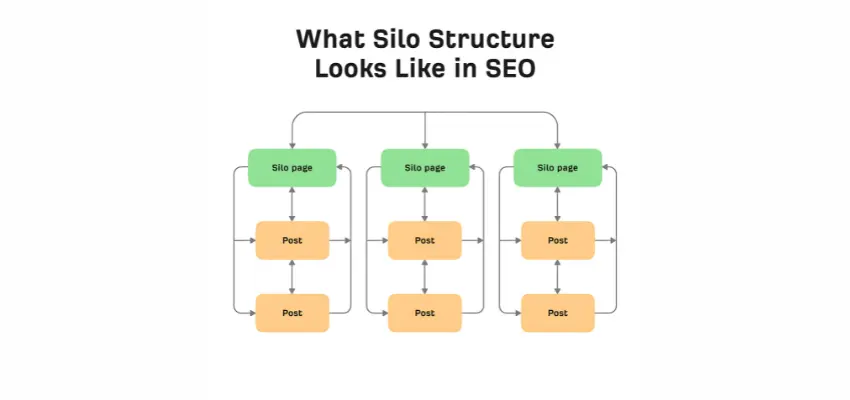What is an SEO Silo?
An SEO silo is a website structure that organizes related content into hierarchical categories, making it easier for search engines to crawl and users to navigate. This method improves content relevance, internal linking, and overall rankings.
Instead of a scattered content approach, silos group related pages under a main category (pillar) with supporting subpages (clusters). This builds topical authority and increases the chances of ranking for multiple keywords.

SEO Silo vs. Topic Clusters: What's the Difference?
SEO Silos: A strict hierarchical structure where content is grouped within separate categories, preventing cross-linking between silos.
Topic Clusters: A more flexible content structure where interlinking between different topics is encouraged for broader relevance.
Both methods are effective, and in 2025, combining them strategically can offer the best SEO results.
Types of SEO Silos
1. Physical SEO Silo (URL Structure-Based)
This type of silo follows a structured URL format to maintain content hierarchy.
Example:
example.com/seo/(Main Category – Pillar Page)example.com/seo/on-page-seo/(Subtopic Page)example.com/seo/off-page-seo/(Subtopic Page)example.com/seo/technical-seo/(Subtopic Page)
2. Virtual SEO Silo (Internal Linking-Based)
A virtual silo does not rely on URL structure but strategic internal linking to create topic-based clusters.
Example:
The pillar page (SEO Guide) links to all related subpages (On-Page SEO, Off-Page SEO, Technical SEO) and vice versa.
These subpages also link back to the pillar page, reinforcing the content hierarchy.
Why SEO Silos Matter for Rankings
1. Improved Crawlability & Indexation
Search engines can crawl siloed websites more efficiently, as pages are grouped by topic and internally linked.
2. Higher Relevance & Keyword Rankings
Grouping content in silos strengthens topical authority, making it easier to rank for primary and long-tail keywords.
3. Enhanced User Experience
Visitors can navigate through structured content easily, reducing bounce rates and increasing engagement.
4. Better Internal Linking & Link Equity Distribution
Silos encourage strategic internal linking, ensuring link equity flows to important pages.
How to Build an SEO Silo for Your Website
Step 1: Identify Core Topics (Pillar Pages)
Choose broad topics that align with your business niche.
Examples: “SEO Guide,” “Ecommerce SEO,” “Local SEO.”
Step 2: Create Supporting Subtopics (Cluster Pages)
Each pillar page should have multiple subtopics.
Example: If “Ecommerce SEO” is a pillar, subtopics could be:
“Product Page Optimization”
“Ecommerce Link Building”
“Technical SEO for Ecommerce”
Step 3: Optimize Internal Linking
Ensure pillar pages link to all subpages and vice versa.
Do not link across unrelated silos to maintain topic relevance.
Step 4: Use a Logical URL Structure
Implement category-based URLs for physical silos.
Example:
example.com/category/subcategory/page
Step 5: Audit & Improve Existing Content
Identify orphan pages and integrate them into the relevant silo.
Update internal links on older content to strengthen the structure.
Best Practices for SEO Silos in 2025
Keep silos tightly themed: Avoid mixing unrelated topics within the same silo.
Balance physical and virtual silos: Use clear URL structures and internal linking together.
Maintain user-friendly navigation: Ensure your menu structure aligns with the silo hierarchy.
Update content regularly: Keep pages fresh and optimized for new SEO trends.
Monitor performance: Use tools like Google Search Console and Ahrefs to analyze how well your silo is performing.
Case Study: How an SEO Silo Increased Traffic by 200%
A digital marketing agency restructured its blog into topic silos, grouping related content together and improving internal linking. Within 6 months:
Organic traffic increased by 200%
Bounce rate decreased by 25%
Ranking for primary keywords improved significantly
This proves that a well-planned silo structure can lead to massive SEO gains. For a detailed analysis, check out the full case study on Search Logistics case study on SEO Silos.
FAQs About SEO Silos
1. What is an SEO silo?
An SEO silo is a structured way to group related content on a website to improve crawlability, internal linking, and rankings.
2. Do SEO silos still work in 2025?
Yes! SEO silos help search engines understand site hierarchy and boost topical authority, making them an effective strategy in 2025.
3. Should I use physical or virtual silos?
Both have benefits. Physical silos (URL structure) improve navigation, while virtual silos (internal linking) offer more flexibility.
4. How do silos prevent orphan pages?
By ensuring that every page is linked within a category, silos eliminate orphan pages and improve site structure.
5. How often should I update my SEO silos?
Regular audits (every 3-6 months) help maintain an effective silo structure and optimize for new ranking opportunities.
Final Thoughts
SEO silos are one of the most powerful techniques to structure your website for maximum rankings. By creating organized topic hierarchies, improving internal linking, and maintaining strong topical relevance, you can enhance your site’s SEO performance in 2025.
If you want to implement SEO silos but don’t know where to start, CG Marketing can help! Get a free website audit today and optimize your site for higher rankings and better user experience.
